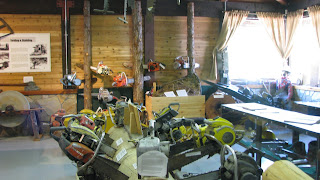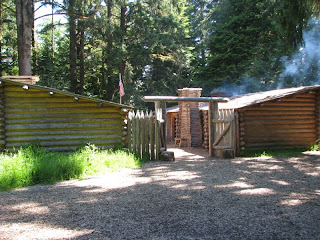July 30 – August 1 , 2013 - Revelstoke, BC
We watched our last paraglider land while we were leaving
the campground this morning. We drove
through Glacier National Park and Revelstoke National Park and got a pleasant
surprise on the road. While we were driving
up Rogers Pass in Glacier National Park, a truck and 5th wheel
passed us with the passenger waving. It
was our friends Barry and Lynn on their way home from their daughter’s place in
Calgary. We stopped at the summit of
Rogers Pass and visited with them for a few minutes. It is quite a coincidence that we were
traveling on the same day. They live in
Agassiz, BC which is east of Vancouver and we are going to visit them after we
leave Revelstoke.
 We are staying at Canada West RV Park just
outside the town of Revelstoke. This is not as nice a campground as we had at Golden and it is
noisy as we are between Hwy 1 and the railroad tracks, but at least there are
not very many mosquitoes. Mariah likes
it because they have a swimming pool. We
changed times zones so we are now on Pacific Time. Unfortunately, the dog’s stomachs are still
on Mountain Time and wanted fed at 4 pm instead of 5 - it will take them a day
or two to adjust.
We are staying at Canada West RV Park just
outside the town of Revelstoke. This is not as nice a campground as we had at Golden and it is
noisy as we are between Hwy 1 and the railroad tracks, but at least there are
not very many mosquitoes. Mariah likes
it because they have a swimming pool. We
changed times zones so we are now on Pacific Time. Unfortunately, the dog’s stomachs are still
on Mountain Time and wanted fed at 4 pm instead of 5 - it will take them a day
or two to adjust.
Wednesday morning we went to the Visitor Center in
Revelstoke to get information about Glacier and Revelstoke National Parks and
the Revelstoke area. We walked around
downtown and did a little shopping but Mariah was not feeling well so we went
back to the campground so she could lie down.
After lunch she stayed at the campground while we went to the BC
Interior Forestry Museum and the Revelstoke Railroad Museum.
The forestry museum had displays about the logging industry
in BC. They had a huge chain saw
collection.
Outside there was a replica of a fire lookout and a lot of
logging equipment - the logs on this trailer were huge.
We next went to the Revelstoke Railway Museum – a very nice museum with lots of displays about the history of the Canadian Pacific Railroad in the Columbia Mountains. A large collection of artifacts, historical photographs, artwork, and full size rolling stock are displayed. The main attraction was engine #5468, a Mikado P-2k class locomotive with a wheel classification of 2-8-2. This oil burning engine was built in 1948 and ran passengers and freight to Kamloops, and sometimes worked as a pusher engine. Diesel engines came to this area in 1953 and #5468 was retired in 1954.
In
the mezzanine the Revelstoke Model Railroad Society is building an HO scale
model train layout depicting railway operations in the Revelstoke area. Outside there was a number of pieces of
rolling stock, including a caboose, road repair car, Jordan Spreader and this
wedge plow. Rex really enjoyed this well
planned museum.
Thursday we drove to Glacier National Park and stopped at the Rogers Pass Discovery Centre. We went through the museum which told the history of the area especially the railroad history. Rogers Pass is in the heart of Glacier National Park – well named as there are more than 100 glaciers within the park. Between 1886 and 1916 the Canadian Pacific Railroad operated a passenger service over Rogers Pass. In 1916, the scenic but hazardous route over the pass was abandoned in favor of an eight kilometer tunnel beneath the pass. Visits to the park dropped dramatically and only a handful of adventuresome climbers saw Rogers Pass each summer until the Trans Canada Highway was completed in 1962.
The Rogers Pass area is very prone to avalanches and this is one of the guns that were used for avalanche control along the highway. Rogers Pass is at an elevation of 1,330 m – 4,364 ft and the views in all directions were beautiful.
We headed back down Rogers Pass toward Revelstoke and stopped to hike the Loop Brook Trail – a 1 mile trail that highlights the stone pillars which once carried the Canadian Pacific Railway trestle across the Loop Brook and back again in a figure-eight shape. These looping trestles allowed the rail line to climb the pass at a gentler grade. Loop Brook was first bridged at two points in 1885. The original wooden trestles were replaced by steel spans resting on stone pillars in 1908. Eight years later the CPR abandoned this part of the line and the stone pillars of Loop Brook Valley were left as monuments.
The trail climbed steeply up to the old rail bed which, fortunately was fairly level. The trail went past a collapsed snow shed that protected the trains from avalanches before it wound its way back down to our starting point.
We enjoyed this short trail and marveled at how a railroad
was built in such rugged, steep terrain.
On down the pass we stopped at the Hemlock Grove Trail. We ate our picnic lunch in the picnic area and then headed out on the short loop trail through the old growth forest. The trail was entirely on a boardwalk – made it very easy to walk.
After our enjoyable walk we left Glacier National Park and 16 km down the road we entered Revelstoke National Park. We stopped at Giant Cedars Trail and took the pleasant short hike through the Cedar Grove – again on a boardwalk.
Some
of the oldest trees in the Columbia Mountains are in this old growth
forest. The largest trees are the
Western Red Cedar and the Western Hemlock.
This trail was much greener and lusher than the Hemlock Grove Trail.
We next stopped at the Skunk Cabbage Trail – an interpretative boardwalk through a wetland. We crossed a small creek at the start of the trail.
This trail along the wetlands was very green and had a large variety of plants. The trail’s namesake, Skunk Cabbage, was very abundant. The signs said that bears especially like the blossoms in the spring.
We enjoyed our short hikes and all the beautiful scenery in
Glacier and Revelstoke National Parks.


.JPG)







.JPG)




.JPG)
Comments
Post a Comment